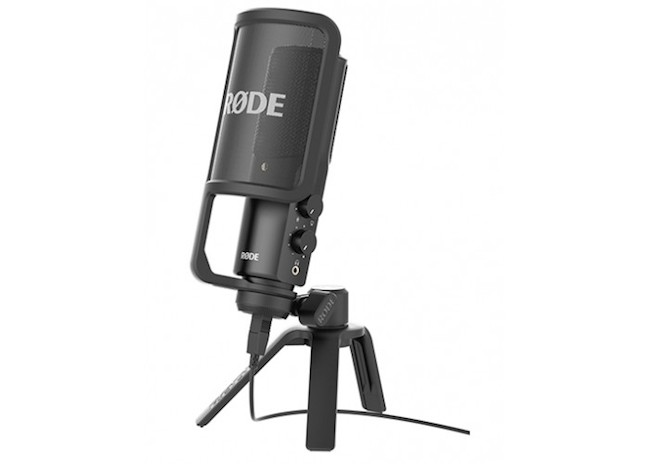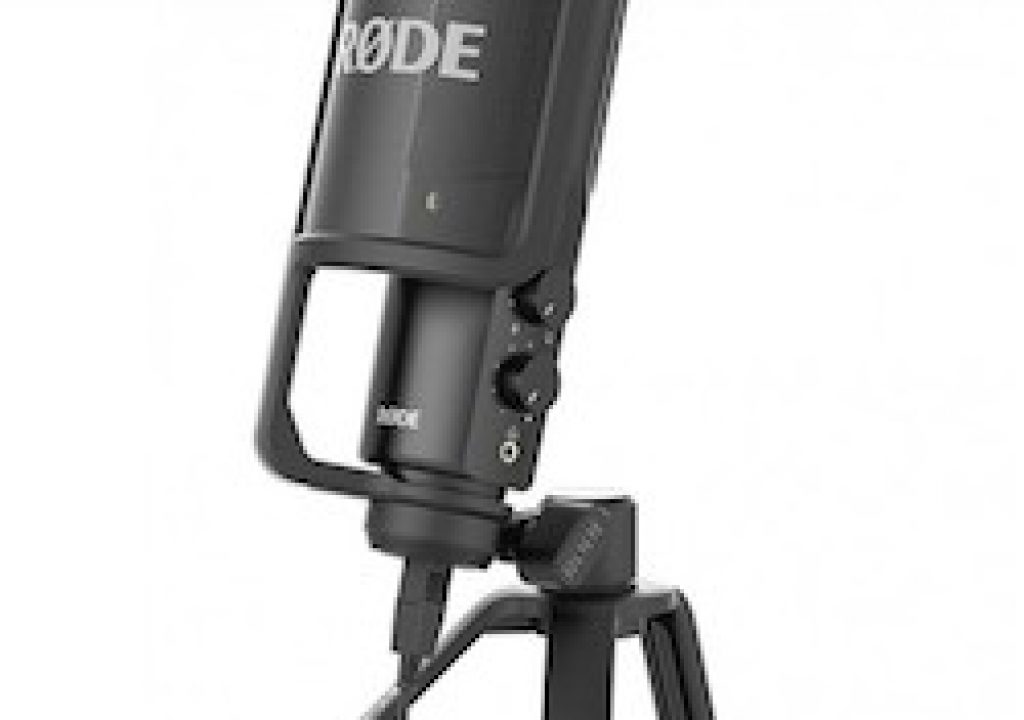
The new NT-USB from RØDE is a studio-grade digital microphone that officially works with Mac, Windows, and iPad. Unofficially, it also works with iPhone and iPod Touch. Ahead is my review, including exclusive comparative audio recordings with Chilean singer Bárbara Intriago.
In this article…
- About the NT-USB microphone
- Sidebar: What do we mean by a digital microphone?
- Compatibility: Mac, iPad, Windows
- What about iPhone and iPod Touch?
- Sidebar: Why the free GarageBand is a waste of your learning time investment
- Exclusive comparative audio recordings I made with Chilean singer Bárbara Intriago
- How do I select the desired sampling frequency between 44.1 kHz and 48 kHz?
- May I use more than one NT-USB microphone together?
- Conclusions
About the NT-USB

The NT-USB is a side-address digital microphone that RØDE markets for recording singing performances, in addition to spoken applications such as podcasting and voiceovers. I would add the application of audiobook production to that list.
What do we mean by a digital microphone?
When we say a digital microphone, we mean that it has a built-in preamplifier, A>D (analog-to-digital) converter, and a digital output. We don’t mean that the actual microphone element is digital (which it is not), just as when we talk about a digital speaker, we don’t mean that the cone is digital… or when we talk about a USB printer, we don’t mean that the actual print head is USB. Some —but not all— digital microphones have an analog headphone output for zero latency monitoring. the NT-USB is one that does.
For some reason, RØDE’s press release and initial web listing for the NT-USB does not indicate the technological classification (i.e. dynamic, condenser, electret condenser, etc.). However, after inquiring with them, they responded that it is an electret condenser.
RØDE quickly points out that the NT-USB is fully compatible with all mainstream recording applications on both Windows and Mac OS based computers, as well as the Apple iPad using RØDE Rec, GarageBand, or any other recording app that accepts an external microphone, be it mainstream or high end. (See my sidebar ahead: Why the free GarageBand is a waste of your learning time investment.) To use the NT-USB with a recent Apple iPad requires the Apple female USB<>Lighning adapter. Use of the NT-USB with earlier iPads requires the Apple Camera Connection Kit. The use of third-party adapters has been quite unpredictable, so I recommend the original Apple items unless you have lots of time to test and return the ones that don’t work for this application. I asked RØDE about potential NT-USB compatibility with iPhone and iPod Touch. The response was that the NT-USB indeed does work with them using the appropriate mentioned adapter, but they didn’t want to state it officially due to battery consumption issues. In other words, if you use it with an iPhone or iPod Touch, your battery may run down quickly.
The body of the NT-USB has a built-in a zero-latency stereo headphone monitoring (3.5mm) jack, which allows you to monitor the microphone input in realtime, along with a dial to adjust the monitoring level and mix between the computer/iPad audio and the microphone input. This will work to sing over a prerecorded sound bed using a mulitrack audio program, or to narrate with a video editing program. For example, see Mark Spencer’s recent The Improved Voiceover Tool in FCP X.
I love the fact that RØDE includes a pop-filter with the NT-USB, to minimize plosives (hard ‘B’, ‘T’ or ‘P’ sounds that produce a harsh sound) during singing or speech recording. The fact that the pop-filter comes included saves users from having to remember to choose and purchase one, or worse, having to discover the plosives issue after it may be too late. Also provided is a 6 meter (20 feet) USB Cable, stand mount with a standard 3/8 inch thread, ring mount, desktop tripod stand, and a pouch. So to be quite clear: you can use the included desktop tripod stand, or any other mic boom or stand that uses the standard 3/8 inch thread.
Why the free GarageBand is a waste of your learning time investment
Apple includes the quite compelling GarageBand application with all Macs. However, GarageBand has unfortunately excluded 48 kHz support since the beginning. 48 kHz is the absolute standard for digital audio for digital video. Whether we are talking about video DVDs, Blu-rays, or HD videotape formats (like HDV, Panasonic’s DVCProHD, Sony’s HDCAM or HDCAM-SR), or DCP (Digital Cinema Package), the standard sampling rate is 48 kHz. Although online video services like Vimeo, Vimeo Pro, and YouTube will certainly accept non-standard video with audio sampling incorrectly sampled at 44.1 kHz, nothing is gained by sampling the audio at a non-standard rate, since Vimeo, Vimeo Pro and YouTube will also accept videos with the standard 48 kHz audio.
Even if today, you only produce audio podcasts and radio spots, at some point, you’ll want to produce some audio for video. Your learning time investment is better focused on applications that support 48 kHz too, so you won’t have to re-learn your skills. Fortunately, most other audio production applications I have ever seen for Mac, Windows, and iOS support 48 kHz, together with other sampling frequencies, including Adobe Audition, Amadeus Pro, Auria, Avid Pro Tools, Fission, and RØDE REC (see review here). The important exceptions (in audio) is BossJock Studio (reviewed here and here), but the developer has promised in writing to include 48 kHz support soon. In video, FilMiC Pro added 48 kHz in 2012, Pinnacle Studio for iPad has just added 48 kHz as default for any iOS device except for the iPhone 4. Even audio podcasters or radio producers (who may only need 44.1 kHz for those venues) will eventually want to include a synchronized video, at least occasionally. The two known workarounds (either to produce non-standard video, or to up-sample the audio) are unacceptable when we have the option to do it right the first time!
On page 2 of this article
- Exclusive comparative audio recordings I made with Chilean singer Bárbara Intriago
- How do I select the desired sampling frequency between 44.1 kHz and 48 kHz?
- May I use more than one NT-USB microphone together?
- Conclusions
Exclusive comparative audio recordings I made with Chilean singer Bárbara Intriago
Below you’ll find an audio recording with the NT-USB microphone with Chilean singer Bárbara Intriago, followed by three other recordings made minutes apart with the AT2005USB hybrid mic from Audio Technica (one of the three identical ones I currently use to produce multi-mic audio podcasts), the digital-only iRig Mic HD from IK Multimedia (recently reviewed here), and the analog Shure Beta 87A (which Bárbara currently uses for most of her live performances). All recordings were done at the audio-for-video standard of 48 kHz. Both the AT2005USB and the Shure Beta 87A were made through the iRig Pro preamp & A>D converter (reviewed recently here). The two digital-only mics used their own preamp and A>D. I didn’t add any equalization or compression. I only applied normalization to these clips.
To download the original WAVE files, and/or if you have difficulty hearing the streaming files here on this page, click on the SoundCloud logo in the corner of the player. You’ll be brought to the files on the SoundCloud site, where you can stream or download.
Here are the published specs of the NT-USB:
- Dynamic range: 96 dB
- Maximum SPL: 110 dB SPL
- Net weight: 520 grams
- A>D converter: 44.1 kHz or 48 kHz (selectable via software), 16-bit
- Pickup pattern: cardioid
- Frequency response: see below
How do I select the desired sampling frequency between 44.1 kHz and 48 kHz?
It is actually much simpler to select the desired sampling frequency from a digital microphone (or A>D converter) on iOS than on Mac. On iOS, you have to select it in a single place, in the recording app, if available (as it fortunately is in RØDE Rec and FilMiC Pro). On a Mac, you must select it in two places with most software I have used: first in the Audio Midi Setup (which is currently located in the Utility folder in modern Macs), and then in the recording app itself. If it is set differently in each place, you will get undesired results, so remember to switch it in both places. I really don’t know where it is switched in the Windows operating system.
May I use more than one NT-USB together?
Some readers may be interested in using multiple NT-USB microphones together. The answer in this case is complex, so let’s take it in three stages.
Using the official digital output
I have never seen any audio mixer with USB or Lightning inputs. Likewise, I have never seen any way to connect more than one digital mic to an iOS device. Although theoretically, you can connect multiple USB mics to a Mac simultaneously by creating an aggregate device via the Audio Midi Setup (which is currently located in the Utility folder in modern Macs), in my personal experience, this feature became unacceptably unreliable with the introduction of Mac OS 10.6 (we are now at 10.9.9). I will only condone this capability again if and when either RØDE or some other reliable source recommends it officially.
Using the headphone (analog) output
RØDE clearly designed the NT-USB to use the USB connection for recording, and the headphone output for live monitoring. The USB port is also used to power the microphone, and for return audio as explained earlier. However, because the headphone output is analog and is latency-free, nothing would prevent you from using that headphone output as a line level signal to feed an analog audio mixer which can accept an unbalanced line level signal (as long as you have properly powered the mic via USB). However, at present, I wouldn’t expect RØDE to provide tech support for this type of use. Proceed with caution if that’s what you have in mind, or look at the following options below.
With multiple recorders
Another way I know to use multiple USB microphones would be to have each record independently on different computers (or iPads) and then combine and synchronize the independent recordings. This is a common feature nowadays in Final Cut Pro X and Adobe Premiere CC and has become very simple to do.
However, if you want to broadcast live or record “live-to-drive” (avoiding post production steps) with multiple mics (and to be completely within the guidelines of the microphone manufacturer), I would recommend the setup described in a prior article, which involves the use of multiple analog mics, and an automatic mixer to avoid crosstalk, and an iRig Pro A>D converter (reviewed here) from IK Multimedia.
Conclusions
The NT-USB from RØDE is expected to be available in September 2014 with an estimated street price of US$169.
Many factors are involved in choosing a microphone. Some of those include the physical format, pickup pattern, esthetic quality, as well as how they may integrate into different situations. Those are all covered in detail within this article.
Upcoming articles, reviews, and books
Stand by for upcoming articles, reviews, and books. Sign up to my free mailing list by clicking here.
Si deseas suscribirte a mi lista en castellano, visita aquí. Si prefieres, puedes suscribirte a ambas listas (castellano e inglés).
My latest book (paperback + ebook)
My most recent book is available in two languages, and in paperback as well as an ebook. The ebook format is Kindle, but even if you don’t have a Kindle device, you can read Kindle books on many other devices using a free Kindle app. That includes iPad, Android tablets, Mac computers, and Windows computers. Although generally speaking, Kindle books are readable on smartphones like Androids and iPhones, I don’t recommend it for this particular book since it contains both color photos and color comparison charts. The ebook is also DRM-free.
In English:
In English, it is currently available in the following Amazon stores, depending upon your region:
- Amazon.com, for the US and other countries in the Americas that don’t currently have their own Amazon store, or anywhere if you simply prefer it
- Amazon.br for Brazil
- Amazon.ca for Canada
- Amazon.de for Germany
- Amazon.es for Spain pero a lo mejor lo preferirás en castellano, a continuación)
- Amazon.fr for France
- Amazon.in for India
- Amazon.it for Italy
- Amazon.co.jp for Japan
- Amazon.com.mx for México
- Amazon.co.uk for the United Kingdom
Or in your favorite bookstore by requesting ISBN–10: 1456310232 or ISBN–13: 978–1456310233.
En castellano:
En castellano, está disponible actualmente en las siguientes tiendas Amazon, según tu región:
- Amazon.com para EE.UU. y todas las Américas donde no existe ninguna tienda particular… o en cualquier parte si simplemente lo prefieres
- Amazon.com.br para Brasil
- Amazon.co.jp para Japón
- Amazon.de para Alemania
- Amazon.es para España
- Amazon.fr (Francia)
- Amazon.in para India
- Amazon.it para Italia
- Amazon.com.mx para México
- Amazon.co.uk para el Reino Unido
o en tu librería preferida al solicitar el ISBN–10: 1492783390 ó el ISBN–13: 978–1492783398.
Allan Tépper’s other books, consulting, articles, seminars & audio programs
Contact Allan Tépper for consulting, or find a full listing of his books, articles and upcoming seminars and webinars at AllanTepper.com. Listen to his TecnoTur program, which is now available both in Castilian (aka “Spanish”) and in English, free of charge. Search for TecnoTur in iTunes or visit TecnoTur.us for more information. FTC disclosure
No manufacturer is specifically paying Allan Tépper or TecnoTur LLC to write this article or the mentioned books. Some of the other manufacturers listed above have contracted Tépper and/or TecnoTur LLC to carry out consulting and/or translations/localizations/transcreations. Many of the manufacturers listed above have sent Allan Tépper review units. So far, none of the manufacturers listed above is/are sponsors of the TecnoTur programs, although they are welcome to do so, and some are, may be (or may have been) sponsors of ProVideo Coalition magazine. Some links to third parties listed in this article and/or on this web page may indirectly benefit TecnoTur LLC via affiliate programs.
Copyright and use of this article
The articles contained in the TecnoTur channel in ProVideo Coalition magazine are copyright Allan Tépper/TecnoTur LLC, except where otherwise attributed. Unauthorized use is prohibited without prior approval, except for short quotes which link back to this page, which are encouraged!


